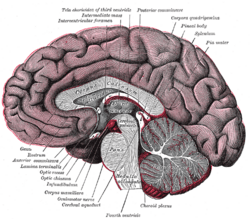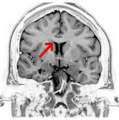Corpus callosum facts for kids
| Brain: Corpus callosum | ||
|---|---|---|
Quick facts for kids
|
||
| Corpus callosum from above. (The front part is at the top.) | ||
| Middle view of the brain. The corpus callosum is in the center, light gray. | ||
| Part of | Human brain | |
| Components | Genu, trunk, splenium | |
The corpus callosum is a very important part of the brain in humans and other placental mammals. Think of it as a superhighway for information! It is the largest connection pathway in the brain.
This amazing structure has over 200 million nerve fibers. These fibers act like tiny wires. They connect the left and right sides (hemispheres) of your brain. This allows the two halves to talk to each other very quickly.
Because the two sides of the brain communicate so much, they can specialize. This means each side can focus on doing slightly different tasks. For example, one side might be better at language, while the other is better at understanding pictures.
Where is it found?
The corpus callosum is special because it is only found in placental mammals. These are mammals that give birth to live young that have developed inside the mother, like humans, dogs, and cats.
You won't find a corpus callosum in animals like monotremes (like the platypus) or marsupials (like kangaroos). It's also not in other animals such as birds, reptiles, amphibians, or fish.
Even though other animals don't have a corpus callosum, they still have ways for their brain halves to communicate. For example, marsupials use a structure called the anterior commissure. This acts as their main connection between the two sides of the brain.
In humans, the corpus callosum grows very large. It even pushes apart some other brain structures called hippocampal structures. This shows how important and big this connection pathway is in our brains.
Images for kids
-
MRI of corpus callosum and its named parts
-
Electroencephalography helps find where seizures start before surgery.
-
A view of the brain after death. The corpus callosum is the curved, lighter band in the middle. Its lighter color means it has more myelin, which helps brain signals travel faster.
See also
 In Spanish: Cuerpo calloso para niños
In Spanish: Cuerpo calloso para niños










